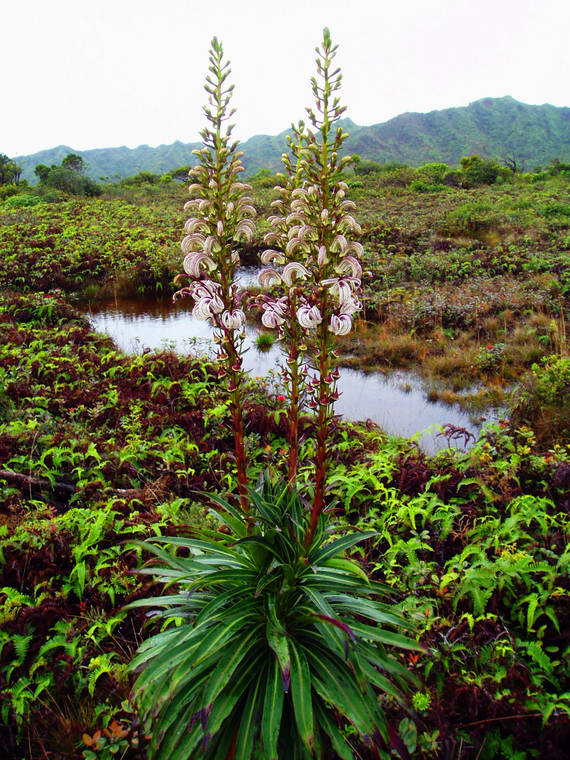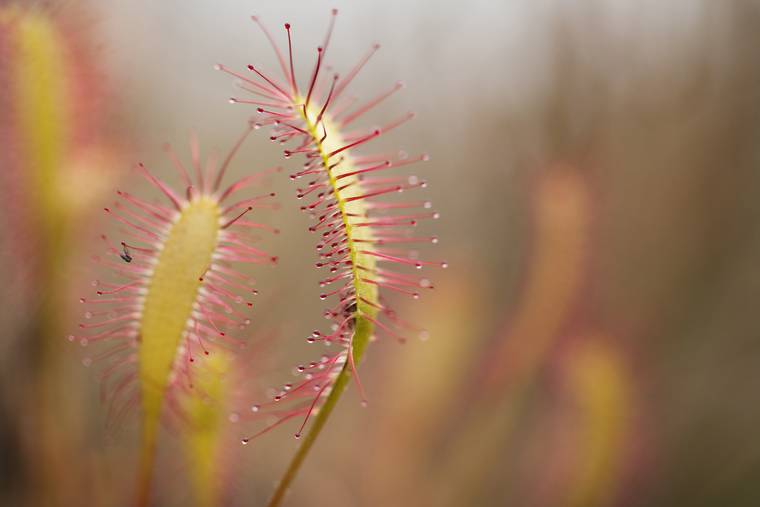Last native lowland bog ‘thriving’



A flesh-eating plant stretches sticky fuchsia tentacles into the balmy air of Kauai’s Kanaele Bog.
It waits until an insect mistakes the shiny droplets on the plant for nectar and lands. The insect gets stuck. The plant secretes more glue. Slowly, the insect is covered and then devoured.
The three-inch-tall plant is called mikinalo, Hawaii’s native sundew. It’s Hawaii’s only carnivorous plant and is found only in the mountain swamps of Kauai.
And recent restoration efforts at Kanaele Bog by The Nature Conservancy is ensuring these tiny plants, and the rest of the wetland, thrive.
“Today, both rare and common native plants are thriving, and the wetland is able to once again collect rainwater that pools and flows down into Kauai’s freshwater aquifer,” said Melissa Fisher, director of TNC’s Kauai forest program.
“Thanks to our strong conservation partnerships, this misty, botanical wonderland is flourishing.”
The bog sits on Alexander &Baldwin land, and before TNC signed a 10-year management agreement in 2003, it was overrun with feral pigs. Those pigs dug up the bog and spread seeds throughout the 80 acres of low-lying wetlands in the Southside mountains above Kalaheo.
So, TNC built a 1.2-mile fence around 58 acres of the bog, stopping the feral pigs.
Then, they started pulling weeds.
In all, TNC has removed 90,618 weeds from the bog. Of those, 82,437 were strawberry guava, 3,917 were Asian melastoma, and 3,267 were clidemia. Smaller numbers of downy rose myrtle and other weed species were also removed.
And it’s brought the bog back to life.
“Hawaii’s last remaining native lowland bog is thriving,” Fisher said.
“Our most recent survey found the bog has 5% shallow water coverage in small perennial pools and 95% plant coverage, 97% of which is native.”
A bog is a wetland maintained by high rainfall or groundwater levels — Kanaele Bog gets 160 inches of rain a year. The soil is shallow, poorly-drained acidic peat.
Native plants that grow within bogs are severely stunted due to the water-saturated, acidic conditions. These specially-adapted plants exist in no other habitat and distinguish Hawaiian bogs from other wetlands.
Intact Hawaiian bogs are few in number, and with the exception of Kanaele, all are at elevations above 3,000 feet. At 2,100 feet, Kanaele is Hawaii’s only remaining native lowland bog ecosystem — “an ecologist’s gem,” according to TNC Senior Scientist and Cultural Advisor Sam ‘Ohu Gon.
Other plants in the bog include native grasses and sedges such as kuolohia, mosses and lichens, as well as dwarfed trees such as olapa and hame, ferns such as uluhe and pala‘a, stunted shrubs of alani and hibiscus, and unique flowering plants such as the rare and showy pu‘e, with its tall spire of white-petaled flowers streaked with purple.
Ohia is also native to the bog. It grows smaller because of the wind and weather at Kanaele, but it’s also preserved. None of the trees have shown signs of the rapid ohia death disease, which is spreading through other parts of Kauai and is on Hawaii Island.
“The plants that we’ve talked about in there (the bog), they’re protected and really starting to thrive,” Fisher said. “It’s been special to see those changes over time.”
Outside the bog fence line, invasive weeds dominate the area and feral pigs continue to dig and create wallows where native plants cannot survive.
“Without our protective efforts, the bog would have suffered a similar fate,” Fisher said.
•••
Jessica Else, environment reporter, can be reached at 245-0452 or jelse@thegardenisland.com.




Is the Kilohana Crater bog part of the Kauai TNC program? In the 1950’s we hiked up to “White House” on a regular basis from Puhi and enjoyed the sights, including to bog.
Aloha James, We are happy to hear you experienced the beauty of Hawaii’s bogs! The Kilohana Crater bog is not on lands we manage. TNC Hawaii